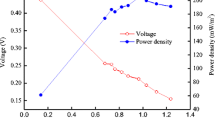Abstract
A new bacterium, Citrobacter sp. Y19, catalyzing the water-gas shift reaction was isolated from an anaerobic wastewater sludge digester. It grew aerobically with a high specific growth rate of 0.7 h−1 in a mineral salt medium supplemented with yeast extract and Bacto-tryptone, and produced H2 under anaerobic conditions after the cells were transferred to tryptone-deleted medium. The maximum H2 production rate was 33 mmol H2 g−1 cell h, which was maintained for about 200 h. This is the first report on a chemoheterotrophic bacterium which utilizes CO with the production of H2 and CO2.
Similar content being viewed by others
References
Altschul SF, Madden TL, Schifer AJ, Zhang J, Zhang Z, Miller W, Lipman DJ (1997) Gapped BLAST and PSI-BLAST: a new generation of protein database search programs. Nucl. Acids Res. 25: 3389–3402.
Ausubel FM, Brent R, Kingston RE, Moore DD, Seidman JG, Smith JA, Struhl K (1989) Current Protocols in Molecular Biology. New York: John Wiley & Sons.
Barik S, Corder RE, Clausen EC, Gaddy JL (1987) Biological conversion of coal synthesis gas to methane. Energy Prog. 7: 157–160.
Bhatnagar L, Krzycki JA, Zeikus JG (1987) Analysis of hydrogen metabolism in Methanosarcina barkeri: regulation of hydrogenase and role of CO-dehydrogenase in H2 production. FEMS Microbiol. Lett. 41: 337–343.
Ferry JG (1995) CO dehydrogenase. Annu. Rev. Microbiol. 49: 305–333.
Jung GY, Jung HO, Kim JR, Ahn Y, Park S (1999) Isolation and characterization of Rhodopseudomonas palustris P4 which utilizes CO with the production of H2. Biotechnol. Lett. 21: 525–529.
Klasson KT, Lundbäck KMO, Clausen EC, Gaddy JL (1993) Kinetics of light limited growth and biological hydrogen production from carbon monoxide and water by Rhodospirillum rubrum. J. Biotechnol. 29: 177–188.
Lane DJ (1991) 16S/23S rRNA sequencing. In: Stackebrandt E, Goodfellow M, eds. Nucleic Acid Techniques in Bacterial Systematics. New York: John Wiley & Sons, pp. 115–147.
Sakazaki R (1984) Genus IV. Citrobacter Werkman and Gillen 1932, 173AL. In: Krieg NR, ed. Bergey's Manual of Systematic Bacteriology, Vol. 1. Baltimore: Williams & Wilkins, pp. 458–461.
Shin YK, Lee J-S, Chun CO, Kim H-J, Park Y-H (1996) Isoprenoid quinone profiles of the Leclercia adecarboxylata KCTC 1036T. J. Mirobiol. Biotechnol. 6: 68–69.
Tanner RS, Miller LM, Yang D (1993) Clostridium ljungdahlii sp. nov., an acetogenic species in clostridial rRNA homology group I. Int. J. Syst. Bacteriol. 43: 232–236.
Uffen RL (1976) Anaerobic growth of a Rhodopseudomonas species in the dark with carbon monoxide as sole carbon and energy substrate. Proc. Natl. Acad. Sci. USA 73: 3298–3302.
Author information
Authors and Affiliations
Rights and permissions
About this article
Cite this article
Yeol Jung, G., Rae Kim, J., Ok Jung, H. et al. A new chemoheterotrophic bacterium catalyzing water-gas shift reaction. Biotechnology Letters 21, 869–873 (1999). https://doi.org/10.1023/A:1005599600510
Issue Date:
DOI: https://doi.org/10.1023/A:1005599600510




